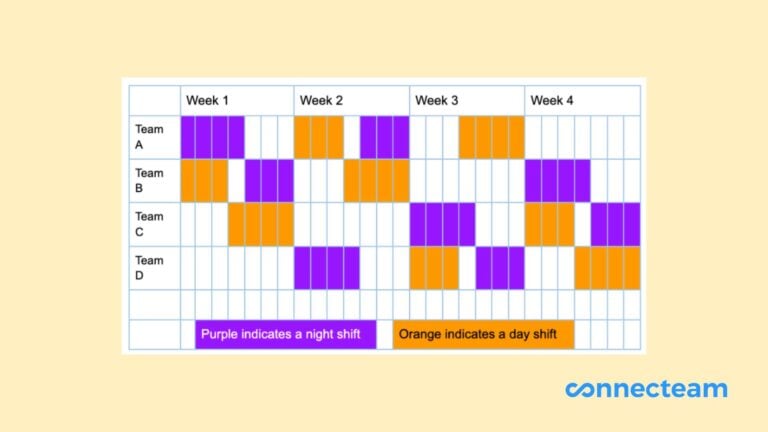The DuPont schedule features rotating 12-hour shifts, ensuring 24/7 coverage. This guide explores its implementation, pros, cons, and industry applications.
Operating a business that runs 24/7 presents more than a few challenges—including finding a schedule that provides 24/7 coverage while keeping employees happy and keeping costs down.
The DuPont schedule is one option. In this article, we review its structure, benefits, challenges, and implementation strategies. Plus, we cover how it compares to other 2/47 scheduling methods.
Key Takeaways
- With rotating 12-hour shifts, the DuPont schedule enables 24/7 operations while giving employees plenty of rest.
- The schedule requires careful management to deal with challenges like employee fatigue and complex shift coordination.
- The DuPont work schedule is especially beneficial in continuous operation industries like healthcare, manufacturing, and emergency services.
- Tools like Connecteam can streamline implementation and ensure compliance with labor laws.
What Is a DuPont schedule?
The DuPont schedule is a rotating work schedule designed for continuous operations, meaning it provides 24/7 shift coverage. This schedule gives employees extended rest periods to offset long shifts and workweeks.
Developed by the DuPont Company in the 1950s, this schedule was initially designed to maximize the use of expensive machinery while providing workers with consistent time off. Its effectiveness in balancing operational needs with employee well-being quickly led to its adoption across various industries that require around-the-clock coverage.
Here are the key features of a DuPont shift schedule:
- The workforce is divided into 4 separate teams.
- Each team works 12-hour shifts, typically consisting of both day and night shifts.
- The schedule rotates over a set cycle, usually 4 weeks (28 days a month).
- By having 2 teams working each day, the DuPont schedule guarantees continuous coverage.
How Does the DuPont Schedule Work?
The DuPont shift schedule operates on a 4-week cycle with each team following a unique 12-hour shift schedule within that cycle. Here’s a detailed breakdown by week.
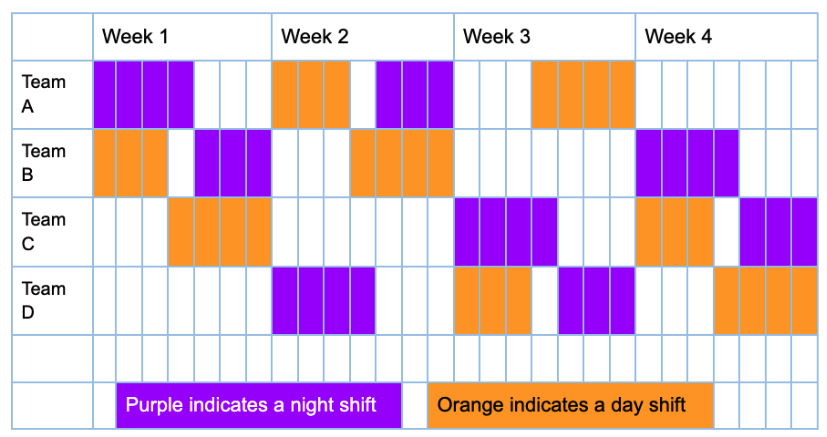
DuPont schedule example—Week 1
- Team A: 4 consecutive night shifts followed by 3 days off.
- Team B: 3 consecutive day shifts, 1 day off, then 3 consecutive night shifts.
- Team C: 3 days off followed by 4 consecutive day shifts.
- Team D: 7 days off.

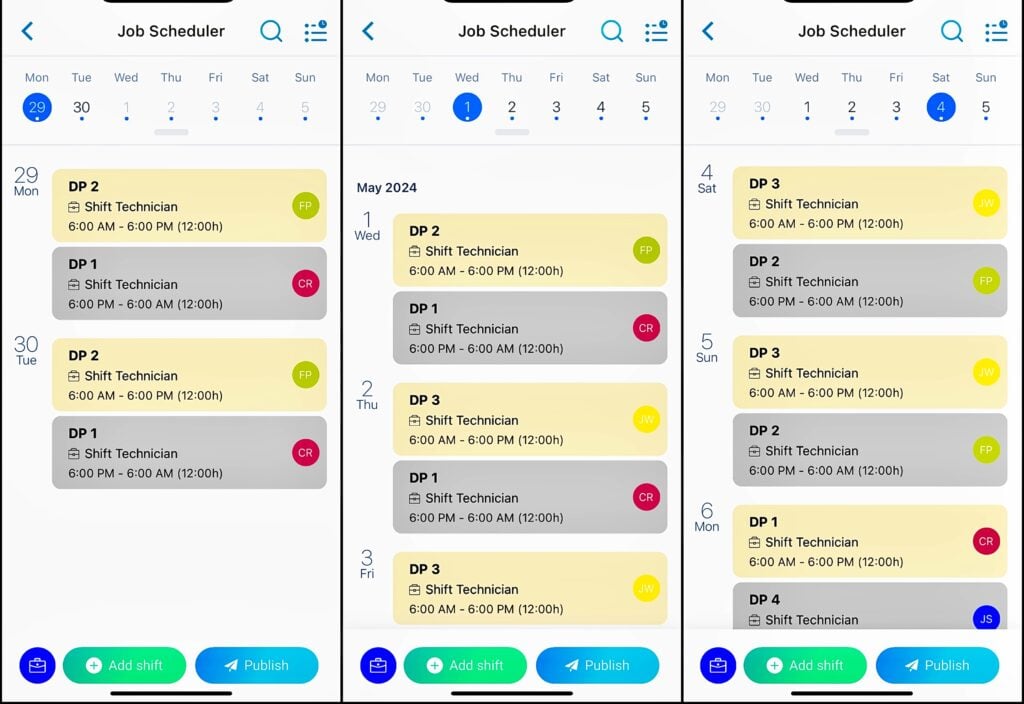
DuPont schedule example—Week 2
- Team A: 3 consecutive day shifts, 1 day off, then 3 consecutive night shifts.
- Team B: 3 days off followed by 4 consecutive day shifts.
- Team C: 7 days off.
- Team D: 4 consecutive night shifts followed by 3 days off.
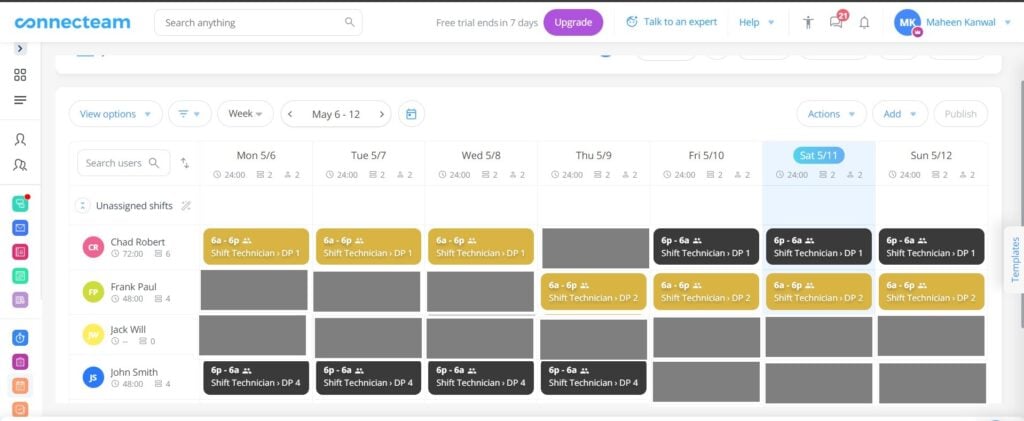
DuPont schedule example—Week 3
- Team A: 3 days off followed by 4 consecutive day shifts.
- Team B: 7 days off.
- Team C: 4 consecutive night shifts followed by 3 days off.
- Team D: 3 consecutive day shifts, 1 day off, then 3 consecutive night shifts.
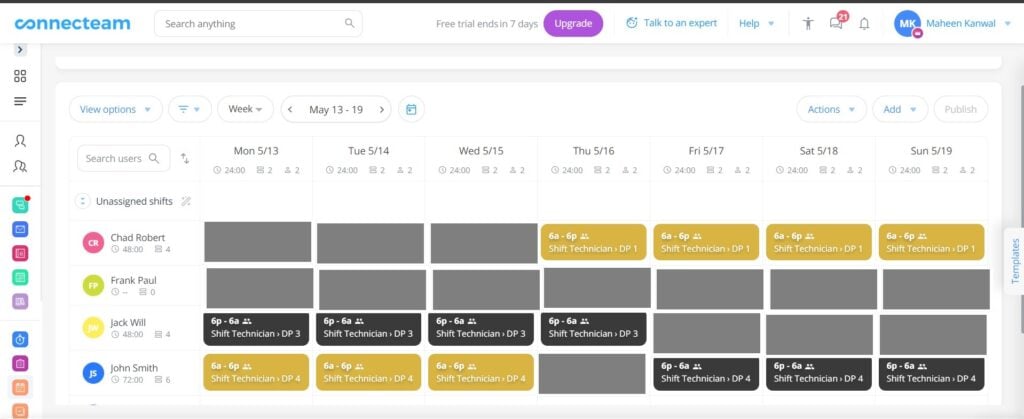
DuPont schedule example—Week 4
- Team A: 7 days off.
- Team B: 4 consecutive night shifts followed by 3 days off.
- Team C: 3 consecutive day shifts, 1 day off, then 3 consecutive night shifts.
- Team D: 3 days off followed by 4 consecutive day shifts.

Full-month overview of the DuPont work schedule
Here’s how the whole month will look:
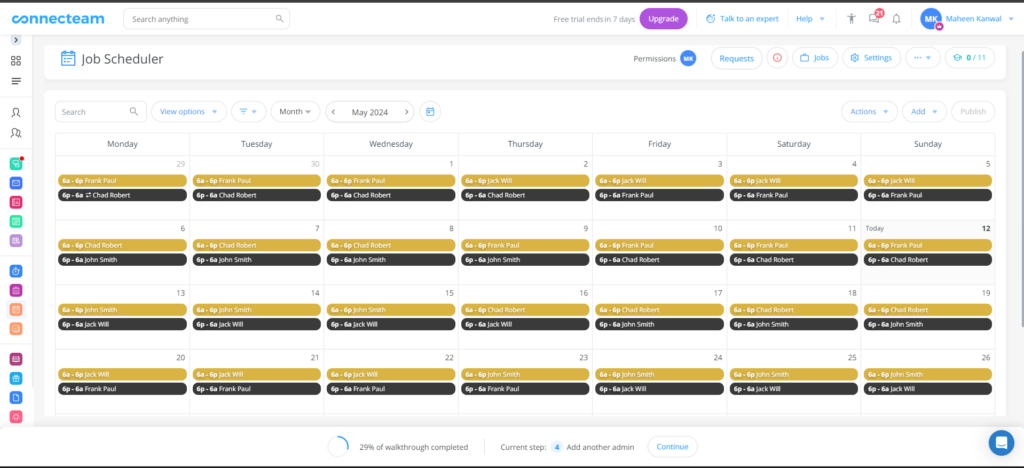
7 Benefits of the DuPont Shift Schedule
Here’s a breakdown of the key benefits of the DuPont schedule.
Benefits for employees:
- Potential for improved work-life balance: Some employees may find that the extended off periods, reaching 7 consecutive days every 4 weeks, provide ample time for rest, personal commitments, and hobbies. This can improve well-being and reduce work-life conflict.
One DuPont employee wrote,“The 7 consecutive days off is what we refer to as a ‘long change’ and it’s an awesome perk to have that every month. It’s the best schedule I’ve seen for 12hr rotating shifts.”
- Fair distribution of shifts: The rotating schedule ensures a balanced distribution of day and night shifts across the 4 teams over the cycle. This can avoid situations where some employees are stuck with undesirable shifts for extended periods.
- Predictable schedule: The 4-week cycle provides a predictable schedule, enabling employees to plan their personal lives and appointments around their work time.
- Reduced commute times: With 12-hour shifts, employees work fewer days a month than they would with traditional 8-hour shifts. This reduction in workdays translates to fewer commutes, saving time and reducing transportation costs.
Benefits for employers:
- Continuous coverage: The DuPont schedule guarantees 24/7 operational coverage, which businesses requiring uninterrupted service need.
- Reduced miscommunications: With fewer shift handovers, there’s less chance for miscommunication and errors, which can disrupt workflow and delay projects.
- Flexibility in workforce management: The schedule allows managers to adjust teams and shift assignments based on real-time needs and employee availability. For example, a manager can quickly reassign a team member from a different shift to cover an absence without disrupting the overall operation.
6 Challenges of the DuPont Schedule
While the DuPont schedule has notable benefits, it also comes with several challenges organizations must manage effectively. Here are some of the main cons and considerations:
- Physical and mental health concerns: The 12-hour shifts—especially during the night—can be physically and mentally demanding. Employees may experience fatigue, disrupted sleep patterns, or stress, which can affect their health and overall well-being. For instance, night shifts can disrupt natural circadian rhythms, leading to sleep disorders.
For example, one Dupont shift employee said, “The biggest problem imo with DuPont is that you rotate from days to nights or nights to days every week. This absolutely wrecks one’s sleep schedule….In my experience, I didn’t want to see or do anything but eat and sleep after working 12+ hrs. I’d rather be rested on my offdays and not having to deal with transition days than the perpetual fatigue and general misery associated with rotating shifts.”
Work-life balance issues: Despite the extended days off, the long hours can strain personal relationships and social life. Employees might find it hard to attend social events or family gatherings if these fall on workdays. This can lead to missed personal moments and resentment.
Another DuPont shift employee wrote, “My best advice is to just make the time count when you have it off. It’s inevitable that you will miss holidays or special occasions..”
- Adaptation period: New employees or those unfamiliar with shift work might find the rotating schedule particularly challenging to adapt to. This can affect their performances and satisfaction.
- Complexity in scheduling: Managing a DuPont schedule requires careful planning and coordination. The complexity increases with the size of the workforce, making it difficult for scheduling managers to balance individual preferences with operational requirements. Scheduling issues can lead to understaffing.
- Employee burnout: Even with breaks, the intensity and length of 12-hour shifts can lead to burnout over time, particularly if employees feel they are constantly in a cycle of recovery from work.
Pro Tip
Use a shift scheduling software like Connecteam to handle complex schedules and prevent understaffing with ease. Create shifts in seconds by using templates or duplicating previous shifts. Use the AI scheduler to assign open shifts based on employee availability, preferences, and qualifications. Prevent absences by automating shift reminders and enabling workers to swap shifts.
Industries That Benefit From the DuPont Schedule
The DuPont schedule is advantageous in industries that require continuous operation, offering a structured yet flexible approach to shift work. Here are some key sectors that benefit from implementing this schedule:
- Healthcare: The DuPont schedule allows for continuous patient care without compromising staff well-being. Extended shifts mean fewer handovers, which can improve the continuity of care.
- Manufacturing: This schedule maximizes machinery usage and production output for manufacturing plants, especially those operating heavy machinery or production lines that are costly to start and stop. It also helps maintain a steady workflow, which is crucial for meeting production targets.
- Emergency services: Police, fire units, and emergency medical services must be available 24/7. The DuPont schedule ensures that these critical services are always staffed, providing the necessary coverage to respond to emergencies effectively.
- Utilities: Energy and utility companies must continuously operate facilities that provide essential services like electricity, water, and gas. The DuPont schedule allows for constant monitoring and maintenance, which can prevent service disruptions.
- Customer service centers: Call centers and customer support facilities that provide round-the-clock service find this schdule beneficial. It helps manage fluctuating call volumes more efficiently while ensuring customer service representatives aren’t overworked.
- Hospitality: Hotels, casinos, and some restaurants require staff availability 24/7. This schedule allows these businesses to meet guest needs while giving staff downtime.
Is the DuPont Schedule Right for My Business?
The DuPont schedule isn’t a one-size-fits-all solution. Here are some key elements to consider when deciding if it’s the right fit for your business.
Operational needs
- 24/7 coverage: Is continuous operation essential for your business? If yes, the DuPont schedule guarantees this.
- Work demand fluctuations: Does your workload experience significant ups and downs? This schedule might not be ideal if frequent overtime is needed to handle peak periods.
Employee considerations
- Work preferences and abilities: Would your employees be receptive to working—and able to work—12-hour shifts and long workweeks? Consider conducting surveys using a survey app or having discussions to assess employee sentiment.
Additional factors
- Industry standards: Is the DuPont schedule common in your industry? Researching common practices in your sector might be helpful. If the schedule isn’t common, this might indicate that it doesn’t align well with industry-specific operational needs.
- Labor costs: While the DuPont schedule can potentially reduce staffing needs, consider the impact of overtime costs if they’re applicable.
- Long-term sustainability: Consider the long-term impacts on employee turnover, recruitment, and overall satisfaction. A schedule that works well for current employees may also be a determining factor for potential hires.
- Legal considerations: Determine whether you’re legally allowed to implement a DuPont schedule—plus the other steps you must take to stay in compliance with laws and regulations. (Find more info on legal considerations below.)
If, after careful evaluation, you find that the benefits of the DuPont Schedule align with your operational needs and can enhance employee satisfaction and retention, it might be the right choice for your business.
Conversely, exploring other options may be more appropriate if the schedule poses too many challenges or doesn’t fit well with employees’ lifestyles.
Implementing the DuPont Shift Schedule: 8 Steps
Adopting the DuPont schedule requires careful planning and consideration. Here’s how you can implement the Dupont shift schedule effectively.
Speak with a labor lawyer
Consider talking to a labor lawyer to understand which labor laws will impact you if you use the DuPont schedule. This way, you’ll know what you must do to comply with these laws.
Engage with stakeholders
Consult with all stakeholders, including management, team members, and unions if applicable. Getting buy-in is crucial, as changes in scheduling affect everyone’s work and personal lives. Employee feedback can provide insights into potential challenges and preferences.
Develop a clear policy
Create a comprehensive shift policy that outlines the schedule and shift rotation—and details how overtime hours are managed (if applicable) and shift preferences are handled. This policy should also address how holidays, leave, and sick days are managed within the rotating schedule.
Offer training and support
Provide training for employees and managers on how the schedule works and the rationale behind its design. Offer support systems for health and wellness, particularly focusing on managing the challenges of shift work, such as sleep hygiene and stress management. For instance, the National Sleep Foundation has resources on sleep hygiene available you might use.
Did You Know?
Connecteam is a training app you can use to deliver custom training sessions on shift work challenges and solutions, health and safety regulations, and ways to manage long hours. Use the AI Course Creator to build custom courses instantly on any topic.
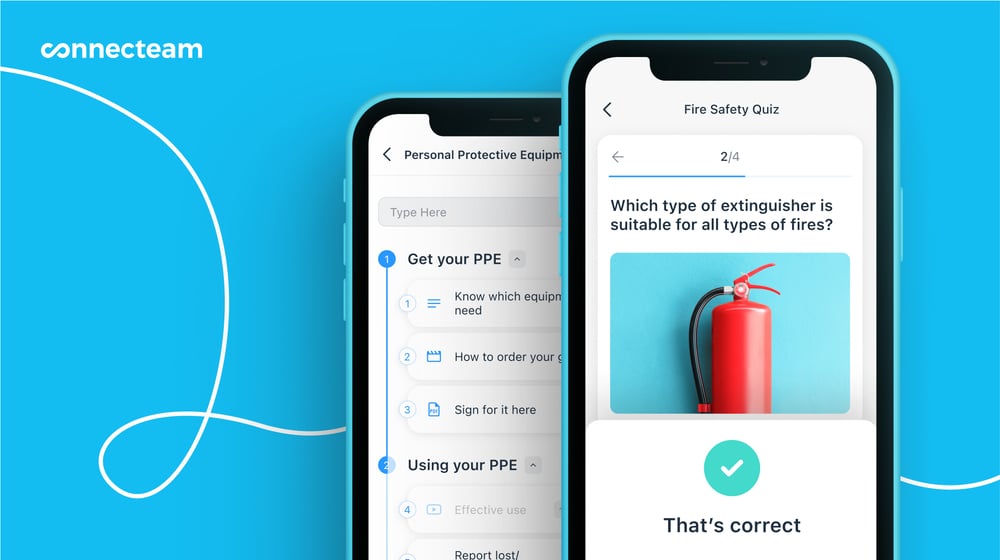
Do a trial period
Consider running a trial period to identify unforeseen issues and make adjustments before fully implementing the schedule. This way, you can refine the schedule as needed.
Use technology for scheduling
Invest in advanced scheduling software like Connecteam that can handle complex patterns like the DuPont schedule. Good software will ease the administrative burden and help avoid errors in shift assignments.
Monitor and adjust
After implementation, continuously monitor the schedule’s impact on business operations and employee well-being. Make adjustments to address any issues related to performance, health, or morale.
Pro Tip
Look at metrics like productivity rates and employee turnover under the DuPont schedule. For example, you can use Connecteam’s reporting features to create custom reports to monitor time taken on projects, attendance, overtime, and more. Then, you can use this information to determine if your DuPont schedule is negatively impacting your workers.
Communicate
Maintain open lines of communication with all employees to ensure they understand their schedules and any changes that might occur. Regular updates and open discussions about the schedule can help alleviate concerns and foster a positive work environment.
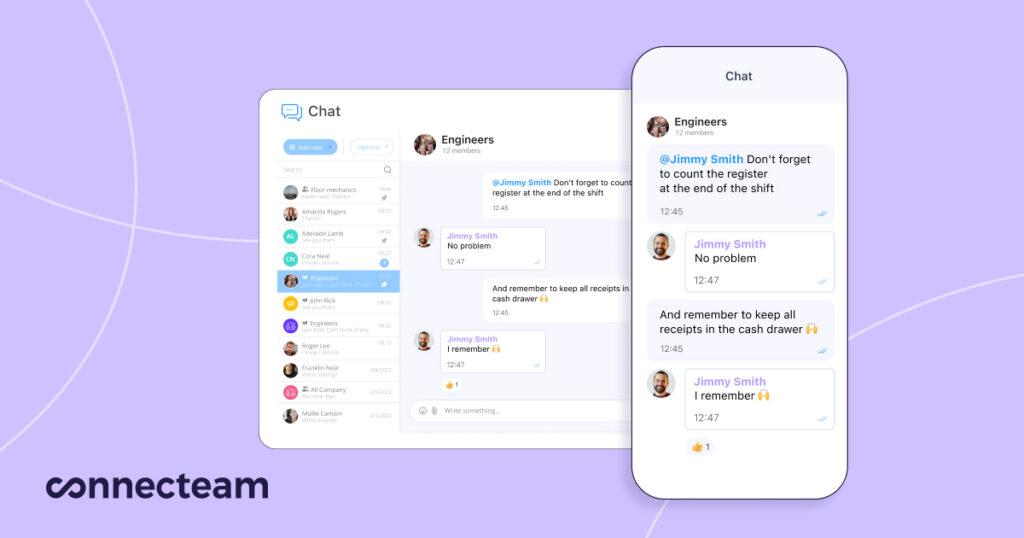
Legal Considerations for Implementing the DuPont Schedule
When implementing the DuPont Schedule, complying with legal and regulatory standards is a must. Here are the key legal areas to consider.
Labor laws and regulations
There are a few labor laws and regulations that might apply to you. Here are some considerations:
- Check local laws concerning work schedules. For instance, in California, alternative work schedules must be adopted by 2/3 of the affected employees. Meanwhile, in New York, fast food employers must provide their workers with consistent week-to-week schedules.
- Ensure that the 12-hour shifts include required meal and rest breaks.
This Might Interest You
Check out our state labor law guides or our meal and rest break laws by state to learn more about meal and rest breaks in specific states.
Overtime regulations
Workers will work 40+ hours during some weeks with the DuPont schedule. For instance, each team will work 72 hours every 4th week. This means non-exempt employees will be eligible for overtime compensation.
Here’s what you must consider.
- Be aware of conditions that trigger overtime compensation (or double time compensation)—such as hours worked beyond the standard workweek—and adhere to regional pay requirements. For instance, in California, any non-exempt employee who works more than 8 hours in a workday will earn overtime for each additional hour.
- Monitor and enforce limits on the number of consecutive hours or days employees can work overtime and pay employees in accordance with local overtime laws.
Pro Tip
With the DuPont schedule, tracking overtime accurately is vital. The Connecteam overtime app can accurately track and calculate overtime hours, ensuring fair compensation and adherence to labor laws. This is particularly valuable in industries where overtime is a standard part of operations.
Health and safety standards
You must also be aware of issues with health and safety that might arise during 12-hour shifts.
Here’s what you can do:
- Address risks associated with fatigue from long shifts, especially in safety-sensitive industries. Worker fatigue hazards include increased accident rates due to lack of alertness, poor eating habits, sleep disorders, and cognitive impairment.
- Use ergonomic and safety practices suitable for long-hour shifts to prevent physical strain and injuries. For instance, adjustable workstations can allow employees to alternate between sitting and standing positions, reducing the risk of musculoskeletal disorders.
- Provide mental health resources and ensure adequate rest periods, particularly for night shift workers. Resources can include access to counseling and stress management services, for instance.
Compliance strategies
- Conduct regular reviews of work schedules against labor laws to ensure ongoing compliance.
- Educate employees about the legal and organizational policies that apply to their work hours, rest periods, and overtime.
- Engage with HR and legal experts to update scheduling practices when laws and regulations change.
4 DuPont Alternatives
When evaluating the DuPont schedule against other shift schedules, it’s essential to understand how each addresses the needs of 24/7 operations.
Traditional 8-hour shifts
This schedule consists of 3 shifts per day, each 8 hours long. It’s familiar to most employees but involves frequent shift changes and more workdays, which reduces consecutive days off.
Pitman shift schedule
Like the DuPont, the Pitman schedule uses 12-hour shifts but operates over a 2-week period, rotating between days and nights. It ensures that no employee works more than 3 consecutive days. Some employees might prefer this. Additionally, the schedule grants a 3-day weekend every other week. However, it doesn’t provide as many consecutive days off as the DuPont Schedule.
Four on, four off
This model has employees work 4 consecutive days, followed by 4 days off. The schedule is consistently predictable in the short term and offers a balance of work and rest, but the block of work days can be taxing.
Panama schedule
The Panama schedule—also known as the 2-2-3 schedule—is similar to the Pitman schedule. However, it often operates on a 28-day cycle where each team runs the same shift (day or night) for 2 weeks and then switches to the opposite for the next 2 weeks. This schedule reduces the frequency of night shifts and provides regular but shorter breaks. But, the frequent transitions can be challenging for some employees to manage.
| Schedule Type | Shift Length | Pattern |
| Traditional 8-hour | 8 hours | Varies |
| Pitman | 12 hours | 2 days on, 2 days off, 3 days on, 2 days off, 2 days on, 3 days off (2-week rotation) |
| Four on, four off | 12 or 8 hours | 4 days on, 4 days off |
| Panama | 12 hours | 2 days on, 2 days off, 3 days on, 2 days off, 2 days on, 3 days off (4-week rotation) |
| DuPont | 12 hours | 4 nights on, 3 days off, 3 days on, 1 day off, 3 nights on, 3 days off, 4 days on, 7 days off (4-week rotation) |
Bottom Line on the DuPont Schedule
With its rotating 12-hour shifts, the DuPont schedule can effectively balance operational demands with employee rest. This makes it a good option for 24/7 industries like healthcare, manufacturing, and emergency services.
Though it’s designed to optimize worker welfare and productivity, it poses some challenges—including potential employee fatigue and the complexity of shift management.
No matter which 24/7 schedule you choose, understanding relevant labor laws and effective scheduling practices is crucial for successful implementation. And using a scheduling app like Connecteam can make creating and managing these schedules much easier.


